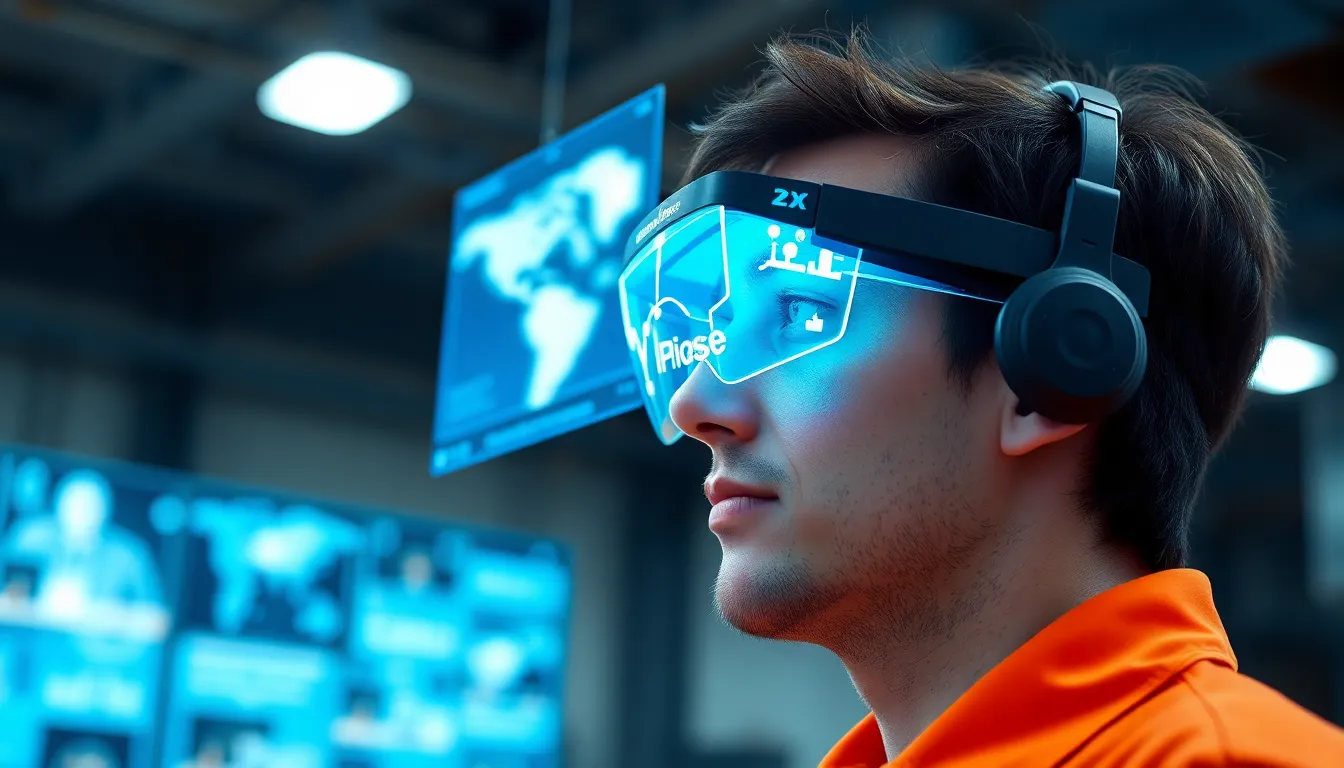In a world where reality sometimes feels a bit too mundane, augmented reality tools swoop in like superheroes, transforming the ordinary into the extraordinary. Imagine pointing your phone at a blank wall and suddenly seeing a life-sized dinosaur lurking behind the couch. Sounds fun, right? These tools are not just for gamers anymore; they’re revolutionizing how businesses, educators, and creatives interact with their audiences.
From virtual try-ons that make shopping a breeze to immersive training programs that keep employees engaged, augmented reality is changing the game. It’s like having a magic wand that adds a sprinkle of excitement to everyday tasks. So, buckle up and get ready to explore how these innovative tools can elevate experiences and make reality just a bit more interesting.
Table of Contents
ToggleOverview of Augmented Reality Tools
Augmented reality tools integrate digital information with real-world environments, enhancing user experiences across various sectors. These tools allow users to visualize content in an interactive manner, making information more accessible and engaging.
Businesses utilize AR tools to provide virtual try-on experiences, enabling customers to visualize products like clothing or accessories before making a purchase. Educational institutions implement AR applications that facilitate immersive learning environments, allowing students to interact with complex concepts.
Creatives adopt AR tools for innovative storytelling, blending the physical and digital worlds to captivate audiences. User engagement increases when AR is applied effectively, as its interactive nature fosters a deeper connection with the content.
The market sees a variety of AR tools available, from software platforms like Unity and ARKit to hardware options such as smart glasses. Effective collaboration among developers, designers, and marketers enhances the capabilities of AR, pushing creative boundaries further than ever before.
Utility in professional training becomes evident through AR simulations that offer realistic scenarios for practice. Workers gain hands-on experience without the risks associated with real-life situations, improving skills and confidence significantly.
Augmented reality tools also support navigation by overlaying directions on real-world views, simplifying the travel experience. This practical application exemplifies ARs potential to streamline everyday tasks, making technology an indispensable ally in various aspects of life.
Diverse augmented reality tools facilitate innovative experiences, transforming interaction across gaming, business, education, and beyond. Their ongoing evolution promises to redefine how users engage with digital content integrated into their daily lives.
Types of Augmented Reality Tools

Augmented reality tools come in various forms, enhancing user experiences through different technologies. Understanding these tools helps in recognizing their diverse applications across multiple sectors.
Mobile Applications
Mobile applications represent a significant segment of AR tools, accessible directly via smartphones and tablets. Users can download apps like Pokémon GO or IKEA Place, allowing for interactive experiences. These applications often require nothing more than a camera and an internet connection to overlay digital content onto the real world. Many industries leverage these apps for marketing purposes or educational initiatives, engaging users through gamification and interactive learning. Recent advancements ensure that mobile AR applications continually evolve, improving usability and functionality.
Wearable Devices
Wearable devices take AR to a new level, providing immersive experiences while keeping users’ hands free. Smart glasses such as Microsoft HoloLens and Google Glass overlay information directly onto the user’s field of vision. These devices serve various purposes, from enhancing industrial training programs to providing real-time data for navigation. Hands-free operation reduces distractions, enabling users to interact with their environments seamlessly. Combining real-world observations with digital enhancements, wearable AR devices drive innovation in fields ranging from healthcare to manufacturing.
Applications of Augmented Reality Tools
Augmented reality tools have transformative applications in various fields. They enhance experiences in education, healthcare, and retail.
Education
AR tools revolutionize the learning environment. Interactive applications foster engagement, enabling students to visualize complex concepts. For example, anatomy lessons come alive through 3D models, allowing detailed exploration of human anatomy. Educators utilize AR to create immersive historical experiences, enhancing retention and understanding. Schools increasingly integrate AR into curricula, making subjects more appealing for students of all ages. As a result, learners enjoy hands-on experiences beyond traditional methods.
Healthcare
In healthcare, AR tools improve training and patient care. Surgeons use AR for overlaying critical information during procedures, enhancing precision. Medical students benefit from simulated scenarios that replicate real-life challenges, promoting skill development without risks. Additionally, AR applications assist in patient education by providing visual explanations of medical conditions. Patients gain better understanding of treatment plans through interactive visual aids. As collaboration between tech developers and medical professionals grows, innovative AR solutions continue to emerge.
Retail
Retail utilizes AR tools to elevate the shopping experience. Virtual try-on solutions let customers visualize products in real-time, reducing return rates. Brands employ AR for interactive marketing, engaging potential buyers through immersive campaigns. For instance, customers can see how furniture fits in their homes before purchasing, making informed decisions. Retailers increasingly implement AR to bridge online and offline shopping experiences. As technology advances, AR-driven applications are expected to further transform how consumers interact with products.
Benefits of Using Augmented Reality Tools
Augmented reality (AR) tools offer numerous benefits across various sectors. Enhanced engagement with users leads to improved interactions in educational, retail, and industrial settings. Immersive experiences spark interest and curiosity, making learning and shopping more enjoyable.
Improved retention of information occurs in educational environments. AR allows students to visualize complex concepts, like anatomy through 3D models. Such visualization aids comprehension, resulting in deeper understanding.
In retail, AR transforms shopping experiences by enabling customers to visualize products virtually. Virtual try-ons for clothing and accessories allow shoppers to see how items look without trying them on physically. This level of convenience often leads to higher conversion rates and customer satisfaction.
In professional training, AR tools provide safe simulations for skill development. Employees practice real-world tasks without the risks associated with hands-on training. This form of training boosts confidence and readiness, particularly in fields like healthcare and engineering.
Simplified navigation represents another crucial benefit. By overlaying directions on real-world views, AR enhances traveler experiences in unfamiliar locations. Users can easily find their way around without constantly referring to maps.
Cost efficiency also stands out as an advantage. Businesses reduce expenses related to physical materials by utilizing AR for training or product demonstrations. Savings on print materials and training setups make AR an attractive option for organizations.
Additionally, collaboration between AR developers and designers leads to innovative solutions. Continuous improvements in AR tools contribute to better user experiences across various applications. These advancements promote ongoing engagement and interaction, further extending the reach and impact of AR technology.
Challenges and Limitations of Augmented Reality Tools
User adoption presents a significant challenge for augmented reality tools. Many individuals remain unfamiliar with the technology, which can hinder widespread acceptance. Training users on how to effectively utilize AR applications requires time and resources.
Another limitation lies in the quality of hardware. Devices such as smartphones and wearables may not support high-end AR features, leading to a subpar experience. Battery life also becomes a concern, as extensive use of AR applications drains power quickly, causing interruptions during critical tasks.
Content creation poses additional obstacles. Developing quality AR experiences requires expertise in 3D modeling and programming. Not all organizations possess the necessary skills, which can limit the availability of innovative content.
Privacy issues also arise with AR tools. Users may feel uneasy about sharing personal data, particularly in applications that track their location or preferences. Ensuring robust data protection measures is essential for building user trust.
Moreover, environmental factors can impact AR experiences. Lighting conditions affect how well AR objects are rendered in real-world environments. Inadequate lighting may lead to poor visibility or misalignment of digital content.
Finally, there exists a concern regarding the potential for information overload. Users might struggle to process excessive information displayed through AR. Striking a balance between enriching experiences and overwhelming users is vital.
Overall, while augmented reality tools offer transformative possibilities, they also carry inherent challenges and limitations that must be addressed.
Augmented reality tools are reshaping how individuals interact with the world around them. Their ability to blend digital information with real-life environments opens up new avenues for engagement in various fields. As businesses, educators, and creatives continue to harness these tools, the possibilities for enhancing user experiences are limitless.
Despite the challenges of user adoption and content creation, the benefits of AR are undeniable. From improved training simulations to immersive shopping experiences, AR is proving to be a game changer. As technology evolves and becomes more accessible, the integration of AR tools will likely become a standard practice, driving innovation and engagement across multiple sectors. The future of augmented reality is bright and full of potential.



